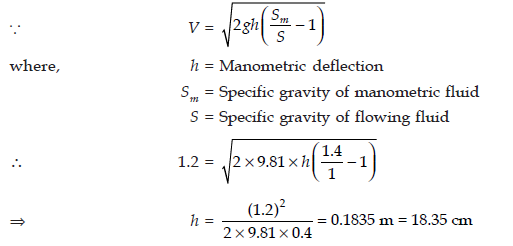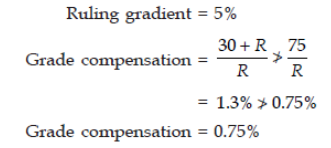ESE (CE) Paper II Mock Test - 2 - Civil Engineering (CE) MCQ
30 Questions MCQ Test - ESE (CE) Paper II Mock Test - 2
Consider the following statements:
- In a composite construction, interface slipping is prevented by using shear connectors.
- A partially prestressed member is one in which tensile stresses and cracking are permitted under service loads.
- The propagation of a shear crack in prestressed concrete member depends on shape of the cross-section of beam.
Which of the above statements are CORRECT?
| 1 Crore+ students have signed up on EduRev. Have you? Download the App |
Consider the following statements:
Maximum shear stress induced in a power transmitting shaft is
1. directly proportional to torque being transmitted.
2. inversely proportional to the cube its diameter.
3. directly proportional to its plane moment of inertia.
Which of the above statements are CORRECT?
An angle connected to the back of the web of channel section is to be used as a beam as shown in figure below. This arrangement is provided to
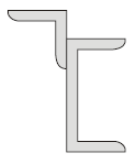
Consider the following statements:
1. RADAR is a passive sensing system.
2. For setting out right angles, the instrument used is ceylong ghat tracer.
3. A liquid of lower viscosity is used in the bubble to increase its sensitivity.
Which of the above statements is(are) CORRECT?
Degree of freedom for the given structure will be (consider all the members as extensible)
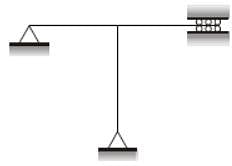
Choose the correct statement(s):
(i) With a prismatic compass, sighting and reading can be done simultaneously.
(ii) Levelling of the compass is achieved by eye judgement.
Match List-I (Element) with List-II (Functions) and select the correct answer using the codes given below the lists:

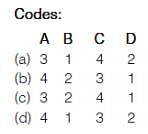
In the following questions two statements are given. Read them carefully and choose from the options given below:
a) Both (A) and (R) are true and (R) is the correct explanation of (A).
b) Both (A) and (R) are true and (R) is NOT the correct explanation of (A).
c) (A) is true but (R) is false.
d) (A) is false but (R) is true.
Assertion (A): Sedimentation tanks are designed to remove and settle the solids by reducing the speed of flow.
Reason (R): As soon as the turbulence is retarded by offering storage to sewage, the impurities tend to settle.
In the following questions two statements are given. Read them carefully and choose from the options given below:
a) Both (A) and (R) are true and (R) is the correct explanation of (A).
b) Both (A) and (R) are true and (R) is NOT the correct explanation of (A).
c) (A) is true but (R) is false.
d) (A) is false but (R) is true.
Assertion (A): In earthquake resistant design of RC structure, very high strength concrete is undesirable.
Reason (R): Higher strength concrete has higher ultimate compressive strain.
Consider the following statements :
1. In a beam, the maximum shear stress occurs at the neutral axis of the beam cross-section.
2. The maximum shear stress in a beam of circular cross-section is 50% more than the average shear stress.
3. The maximum shear stress in a beam of triangular cross-section, with its vertex upwards occurs at b/6 above the neutral axis.
Which of these statements are correct?
Principle of minimum strain energy is
- a particular case of Castigliano’s 1st theorem.
- a particular case of Castigliano’s 2nd theorem.
- applicable only when the redundant supports do not yield.
- applicable even when the redundant supports yield.
Select correct answer using codes given below:
Gantry girders can be designed
- for use in multistorey buildings.
- as laterally unsupported beams.
- using channel sections only.
Which of the above statements is(are) CORRECT?
In the following questions two statements are given. Read them carefully and choose from the options given below:
a) Both I and II are true and II is the correct explanation of I.
b) Both I and II are true and II is NOT the correct explanation of I.
c) I is true but II is false.
d) I is false but II is true.
Statement (I): The surface overflow rate (SOR) physically represents the settling velocity of the slowest settling particles that are 100% removed in an ideal settling basin.
Statement (II): SOR of sedimentation basin is numerically equal to the flow rate divided by plan area of sedimentation basin.
A Pitot static tube is used to measure the velocity of water using a differential gauge which contains a manometric fluid of relative density 1.4. The deflection of the gauge fluid when water flows at a velocity of 1.2 m/s will be [the coefficient of the Pitot tube may be assumed to be 1]
The grade compensation to be provided at a highway curve of radius 100 m with a ruling gradient of 5% will be
A beam of square cross-section of side ‘a’ is made of material whose yield stress in compression is 3 times of the yield stress in tension. What is the distance of the neutral axis from the centre of beam cross-section for the fully plastic condition?
As the span of a bridge increases, the impact factor
The thickness of web for plate girder provided with vertical stiffener with clear distance ‘d’ between the flanges shall not be less than
Consider the following statements:
- Slip occurs more readily when the atoms are far away from each other.
- The direction in which that the dislocation moves is called the slip direction, and the planes impacted by the slip are called the slip planes.
- The stress required to induce slip increases exponentially with increasing interplanar spacing.
Which of the above statements is/are correct?
Consider the following statements regarding plastic deformation region of stress strain curve.
- Material returns to its original form when stress is released, no lasting damage and region is usually a straight line.
- The material has failed here after going through plastic deformation; a brittle material fails immediately after elastic deformation.
- Material cannot completely recover when stress is released because of permanent microstructure changes.
Which of the above statements is/are correct?
The maximum thermal stress in a circular tapering section is
- directly proportional to the bigger diameter.
- directly proportional to the smaller diameter.
- inversely proportional to the bigger diameter.
- inversely proportional to the smaller diameter.
Which of the above statements are CORRECT?
The normal stress on the section AB for the figure shown below, will be
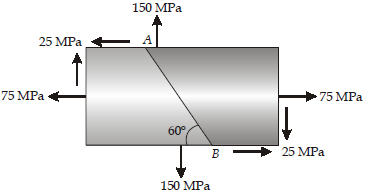
In a water-shed, four raingauges I, II, III and IV are installed. The depth of normal annual rainfall at these stations are 70, 75, 80 and 105 cm respectively. The raingauge at station III went out of order during a particular year. The annual rainfall for that year, recorded at the remaining three stations was 90, 65 and 75 cm respectively for raingauges I, II and IV. The rainfall at station III can be considered as
For a sandy soil with soil grains spherical in shape and uniform in size, the maximum value of ratio of volume of voids to volume of soil is
Which steel member section among the following combinations can carry maximum load?
Consider the following statements:
- The buoyant force is equal to the weight of the fluid displaced by the solid body and always acts upwards through center of gravity of submerged portion of solid body.
- A submerged body is stable if the center of gravity of the body lies below the center of buoyancy.
- A large metacentric height in a vessel weakens stability and makes time period of oscillation shorter.
Which of the above statements is(are) CORRECT?



 more than the average shear stress.
more than the average shear stress.
